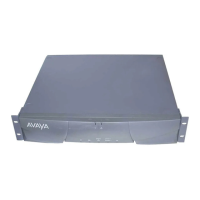Maintenance Commands
555-233-143
7-6 Issue 1 May 2002
Common Input Parameters
Characters in bold type are entered literally on the command line. Characters in
italic bold type are variables. See Table 7-1 for common test-command
parameters and their explanations, and for explanations of less common
parameters.
For example, display cabinet requires only the entry of UU: display cabinet 12.
Test port requires a location of the form UUCSSpp: test port 05c1506 to test
port circuit 6 on the circuit pack in cabinet 5, carrier C, slot 6. The
list and display
commands are useful in relating Maintenance Object (MO) locations to
information such as PN number, extension, link numbers, and so forth. Table 7-2
contains information about the less-common command parameters.
Table 7-1. Common Test Command Parameters
Parameter Range Meaning
Uc 1-64 Specify cabinet number and carrier for S8700 Media Server
you want to test.
UU 1-64 1-digit to 2-digit cabinet number
C A–E Letter designation of a carrier. For many commands relating to
EPN Control circuit packs, this defaults to A, the control carrier.
SS 1–21 1- or 2-digit number identifying a circuit pack’s slot in a carrier.
For many commands relating to EPN Control circuit packs, this
usually defaults to the only possible slot number.
pp 1–24 1- or 2-digit number identifying an individual port circuit on
circuit pack. The range of this variable differs depending on
the type of circuit pack.
Table 7-2. Less-Common Test Command Parameters
Parameter Range Default Meaning
PN# 1- or 2-digit port network number. EPN cabinets may
contain one or two port networks. Use list cabinet to find
which port networks are in each cabinet.
print This command executes immediately (if resources are
available) and sends output both to the screen and to a
printer connected to the terminal where the command was
entered. This option is available for the display, list, and
status commands.
Continued on next page

